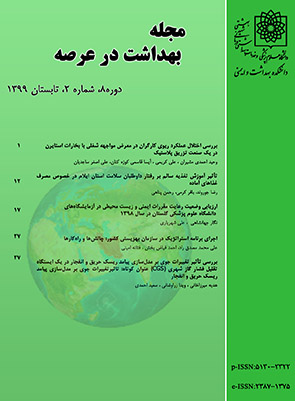بررسی تأثیر تغییرات جوی بر مدلسازی پیامد ریسک حریق و انفجار در یک ایستگاه تقلیل فشار گاز شهری (CGS) عنوان کوتاه: تاثیرتغییرات جوی بر مدلسازی پیامد ریسک حریق و انفجار
فصلنامه علمی پژوهشی بهداشت در عرصه,
دوره 8 شماره 2,
14 آذر 2020
,
صفحه 44-56
https://doi.org/10.22037/jhf.v8i2.30676
چکیده
زمینه و اهداف: ایستگاههای تقلیل فشار گاز شهری نقش مهمی در برنامهریزی ایمنی و مدیریت بحران شهری دارد. مطالعه حاضر با هدف بررسی تأثیر تغییرات جوی بر فاصله اثر حریق و انفجار یکی از ایستگاههای CGS شهر قزوین طی در سال 1397 انجام شد.
مواد و روشها: در این مطالعه هشت وضعیت آب و هوایی غالب استان، بررسی گردید. میانگین دادههای 3 سال مربوط به پارامترهای جوی از سازمان هواشناسی استان قزوین تهیه شد. در ادامه با بررسی مطالعات ارزیابی ریسک ایستگاه مورد مطالعه و ایستگاههای مشابه در سالهای قبل و تهیه نقشههای توپوگرافی و اطلاعات فرآیندی انجام پذیرفت. سپس نوع و مشخصات سناریو محتمل تعیین و شبیه سازی پیامد ریسک حریق و انفجار با استفاده از نرمافزار PHAST نسخه 7.11 صورت گرفت. در طول مدت مطالعه، کلیه موازین اخلاقی رعایت گردید.
یافتهها: تغییرات جوی بر پیامد ریسک حریق و انفجار در ایستگاه CGS موردنظر مؤثر بود به گونهای که بر اثر کاهش و افزایش دمای هوا، در زمستان کمترین ( m5/278) و در تابستان بیشترین (m 8/321) طول شعله حریق به دست آمد. در زمستان، فاصله و ناحیه خطری که تحت تأثیر انفجار قرار میگیرد به m 686، کاهش یافت. همچنین در این فصل در ساعات روز، طول شعله افزایش و فاصله اثر به اندازه m4/9 کاهش یافت.
نتیجهگیری: افزایش دمای هوا، پایداری جو، شار تابشی خورشید، فلو گاز طبیعی داخل خط لوله و افزایش فشار گاز طبیعی داخل خط لوله موجب افزایش فاصله اثر اطراف ایستگاه و افزایش رطوبت نسبی موجب کاهش فاصله اثر اطراف ایستگاه میگردد.
- حریق
- انفجار
- مدل سازی
- تغییرات جوی
ارجاع به مقاله
مراجع
Golmohammadi R, khaefi N, Aliabadi M. Occupational Noise and Control Plan Presentation in Town Board Stations Assessment. Journal of Sabzevar University of Medical Sciences 2019; 26(3):319-27 (In Persian).
Mohammadfam I, Bastani S, Es-haghi M, Golmohamadi R, Saei A. Assessment of working interactions of emergency team members using social network analysis. Journal of Health and Safety at Work 2014; 4(3):37-48 (In Persian).
Yousefzadegan MS, Masoudi AM, Ashtiani YK, Kambarani M, Pishbin SI. Consequence Analysis for probable accidents of filter separators installed in Gas Pressure Reduction Stations. Proceedings of the 2nd International Conference on Environmental Science and Development IPCBEE. 2011 Jan. 7-9; Mumbai, India. p:115-119.
Zarei E, Jafari MJ, Dormohammadi A, Sarsangi V. The Role of modeling and consequence evaluation in improving safety level of industrial hazardous installations: A case study: hydrogen production unit. Iran Occupational Health Journal 2013; 10(6):54-69 (In Persian).
Khosravirad F, Zarei E, Mohammadfam I, Shoja E. Analysis of root causes of major process accident in town border stations (TBS) using Functional Hazard Analysis (FuHA) and Bow tie Methods. Journal of Occupational Hygiene Engineering 2014; 1(3):19-28 (In Persian).
Kamaei M, Alizadeh SSA, Keshvari A, Kheyrkhah Z, Moshashaei P. Risk assessment and consequence modeling of BLEVE explosion wave phenomenon of LPG spherical tank in a refinery. Journal of Health and Safety at Work 2016; 6(2):10-24 (In Persian).
Jahangiri M, Parsarad A. Determination of hazard distance of chemical release in a petrochemical industry by chemical exposure index (CEI). Iran Occupational Health Journal 2010; 7(3):55-62 (In Persian).
Khorram R. Modeling the Consequences Release of Cyanogen agents in Bushehr Nuclear Power Plant Neighborhood Using PHAST, ALOHA and WISER Software. Iran Occupational Health 2020; 17(1):1-13 (In Persian).
Golbabaie F, Avar N, Mohammadfam I. Dispersion modeling of propane leakage from an industry. Humans and Environment 2012; 10(20):1-13 (In Persian).
Abdul Hamidzadeh B, Badri N. Quantitative and qualitative risk assessment in process industries and description of industrial hazard identification methods focusing on HAZOP method. Tehran: Andishesara 2014; P:12-56 (In Persian).
Mays G, Smith PD. Blast Effects on Buildings: Design of Buildings to Optimize Resistance to Blast Loading. Londen: Thomas Telford Publication 1995; P:24-45.
Jafari MJ, Mahabadi ZB, Atabi F, Omidi L, Asl NKJJoHitF. Indoor and outdoor concentrations of volatile organic compounds at two administrative buildings in the center of Tehran. Journal of Health in the Field 2016; 3(4):9-16 (In Persian).
Cheraghi H, Soltanzadeh A, Ghiyasi S. Consequence modeling of the ethylene oxide storage tanks explosion using the PHAST software (a case study in a petrochemical industry). Iranian Journal of Health and Environment 2018; 11(2):261-70 (In Persian).
Harati B, Karimi A, Askari A, Dehghani F, Nasrollahi A. Modeling and evaluation of safety consequences of propylene oxide leakage, a petrochemical company. Journal of Health and Safety at Work 2018; 8(2):199-209 (In Persian).
Beheshti MH, Hajizadeh R, Mehri A, Borhani Jebeli MJIOH. Modeling the result of hexane leakage from storage tanks and planning a emergency response programm in a petrochemical complex. Iran Occupational Health 2016; 13(1):69-79 (In Persian).
Yang R, Gai K, Yang F, Zhang G, Sun N. Simulation of pressure tank leakage based on PHAST. IOP Conference Series: Materials Science and Engineering, Volume 592, Proceedings of the International Conference on Manufacturing Technology, Materials and Chemical Engineering 2019 Jun 14-16; Wuhan, China.
Shahedi ali abadi S, Assari MJ, Kalatpour O, Zarei E, Mohammadfam I. Consequence modeling of fire on Methane storage tanks in a gas refinery. Journal of Occupational Hygiene Engineering 2016; 3(1):51-59 (In Persian)
Panahi S, Karimi A, Pourbabaki R. Consequence modeling and analysis of explosion and fire hazards caused by methane emissions in a refinery in cold and hot seasons. Journal of Health in the Field 2020; 7(4):34-46 (In Persian)
Khakkar S, Ranjbarian M, Pouyakian M. Study of CFSES software compliance with Iranian national standards for fire safety assessment of commercial complexes. Journal of Health in the Field 2019; 7(1):26-35 (In Persian)
Pourbabaki R, Karimi A, Yazdanirad S. Modelling the consequences and analysing the dangers of carbon disulfide emissions using ALOHA software in an oil refinery. Journal of Health in the Field 2018; 6(3):1-9 (In Persian).
- چکیده مشاهده شده: 228 بار
- PDF دانلود شده: 161 بار
